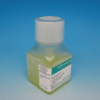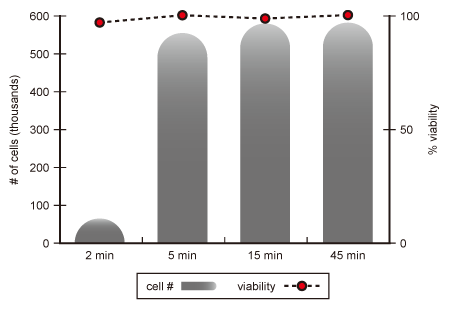Cell Dissociation Reagents (Accutase)

Accutase is a ready to use cell detachment solution, which is non-mammalian, non-bacterial replacement for all applications of trypsin.
Features
- Gentle and efficient dissociation of any adherent cell line
- No mammalian or bacterial components are contained
- No neutralization steps by serum or trypsin inhibitors are required
- Works extremely well on embryonic and neuronal stem cells
Cell Lines Tested
Cell Lines Cryopreserved with Accutase™
- hESCs
- vascular endothelial cells
- hepatocyte progenitors
- adherent CHO cells
- 293 cells
- 3T3
- HeLa
- M24 metastatic melanoma
- gliomas D54
- fibroblasts
- hepatocytes
- primary chick embryo neuronal cells
- adherent BHK cells
- L929 cells
- Vero
- NT2
- A375 metastatic melanoma
- HT1080 fibrosarcoma cells
- keratinocytes
- vascular smooth muscle cells
- bone marrow stem cells
- macrophages
- immortalized mouse testicular germ cells
- COS
- MG63
- gliomas U251
- Sf9 insect cells
Applications
Human MG63 Fibrosarcoma cells cultured in DMEM + 10% FBS were treated with Accutase. Treatment resulted in rapid cell detachment, a single cell suspension, and high viability. Accutase is gentle on cells; viability was 97 ± 3% even after 45 minutes in Accutase.

Protocols
FOQ
Q: What are the target cell lines that Accutase was designed for?
A: Accutase can be used whenever gentle and efficient dissociation of any adherent cell line is needed. Accutase is a direct replacement for trypsin.
Q: What is the difference between Accutase and Accumax?
A: Accumax contains the same proteolytic and collagenolytic enzymes as Accutase, but is formulated at a concentration that is 3X higher and does not contain phenol red.
Q: What color should my Accutase be when it arrives?
A: Please see this document for information, including photos, about the effects of shipping on the color of Accutase - what's normal and what's not.
Q: Is Accutase the same as StemPro or Detachin? If I buy Accutase from a distributor, is it the same product that you sell?
A: Yes. Innovative Cell Technologies is the sole manufacturer of Accutase and Accumax internationally. Our products have different names depending on which company is selling them, but all are manufactured by us, in-house.
Q: Can I use Accutase to dissociate non-adherent clumpy cells?
A: Yes. Accutase can be used to dissociate spheres of neural progenitors (neurospheres). However, if the clumps do not dissociate completely, then consider using Accumax which contains the Accutase enzymes, but at a higher concentration.
Q: The frozen bottle of Accutase shows uneven color distribution and upon thawing it has layered color distribution. Is this normal?
A: Yes. During the defrosting procedure or shipping, uneven color can be observed. However, this will not compromise the activity or performance of Accutase. Just be sure to mix the defrosted Accutase by inverting the bottle to get even color before use.
Q: The Accutase or Accumax arrived partially thawed. Can I still use it?
A: Yes. As long as the product contains an "ice-cube" or is cool to the touch it can be placed in the refrigerator for later use. It also can be refrozen for long term storage (if frozen within two months of receipt)with white Paper on this.
Q: I did not read the insert thoroughly and thawed it at 37°C. Can I still use it?
A: If it was exposed to 37°C just until complete thawing was achieved without raising its temperature to 37°C, it still can be used. However, it could result in decreased enzyme activity and it may take more time to get full dissociation. If you observe this, consider starting with a new bottle. If a bottle of Accutase or Accumax is kept at 37°C for more than one hour, it will lose its activity.
Q: Do I need to aliquot and refreeze Accutase or Accumax after I defrost a bottle?
A: No. Once thawed, it is stable for at least 2 months in the refrigerator if stored promptly after use.
Q: Do I need to wash my cells before adding Accutase?
A: No - pour off the media and add enough Accutase to cover your cells and wait for them to "ball up".
Q: Do I need to stop the dissociation action of Accutase with serum?
A: Usually not. Accutase is gentle enough that only dilution of the reagent with DPBS or media is required to stop the dissociation activity. In the unusual cases where inactivation is required, the standard trypsin inhibitors will work, such as soybean trypsin inhibitor.
Q: Do I need to wash Accutase out after using?
A: No, this is one of the advantages of using Accutase.
Q: Do I need to dilute Accutase before use?
A: No. Accutase is supplied as a convenient, ready to use reagent. No dilution is required prior to use.
Q: How long should I leave the Accutase on my cells?
A: Detachment times for Accutase are similar to trypsin. This time should be determined empirically. Look under the microscope and watch them turn from spidery to little balls. In general, cells can be left in Accutase without damage for a much longer time than trypsin.
Q: What is Accutase made from?
A: Accutase contains no mammalian or bacterial components. It is a natural enzyme mixture with proteolytic and collagenolytic enzyme activity. This means it mimics the action of trypsin and collagenase at the same time. However, because it is more efficient than mammalian trypsin & collagenase, it is formulated at a much lower concentration making it less toxic, and gentler but just as effective.
Q: Do I need to worry about over-dissociating my cells with Accutase?
A: No. However, although Accutase is gentle on cells, the optimal time for dissociation should be determined for your specific cell type and application.
Downloads
Cell Culture Reagents ![]() (PDF 2.4MB)
(PDF 2.4MB)
References
- Fukusumi, H. et al. Small-scale screening of anticancer drugs acting specifically on neural stem/progenitor cells derived from human-induced pluripotent stem cells using a time-course cytotoxicity test. PeerJ. 6, e4187 (2018).
- Uchimura, T. et al. A human iPS cell myogenic differentiation system permitting high-throughput drug screening. Stem Cell Res. 25, 98-106 (2017).
- Yamamichi, K. et al. Amelogenin induces M2 macrophage polarisation via PGE2/cAMP signalling pathway. Arch Oral Biol. 83, 241-251 (2017).
- Yamamoto, Y. et al. Long-term expansion of alveolar stem cells derived from human iPS cells in organoids. Nat Methods. 14(11), 1097-1106 (2017).
Ordering Information
(Storage) RT: Room temperature, A: Cool and dark, R: Refrigerator, F: Freeze
Accutase is registered trademark of Innovative Cell Technologies, Inc.



